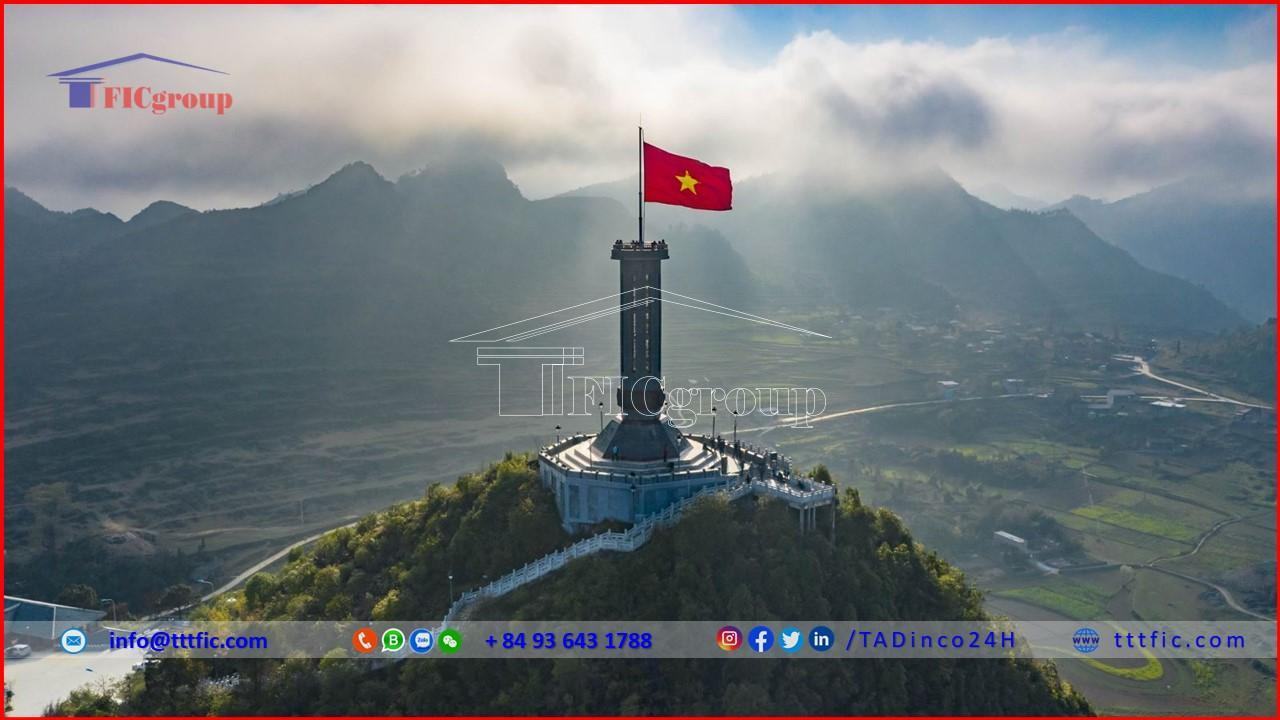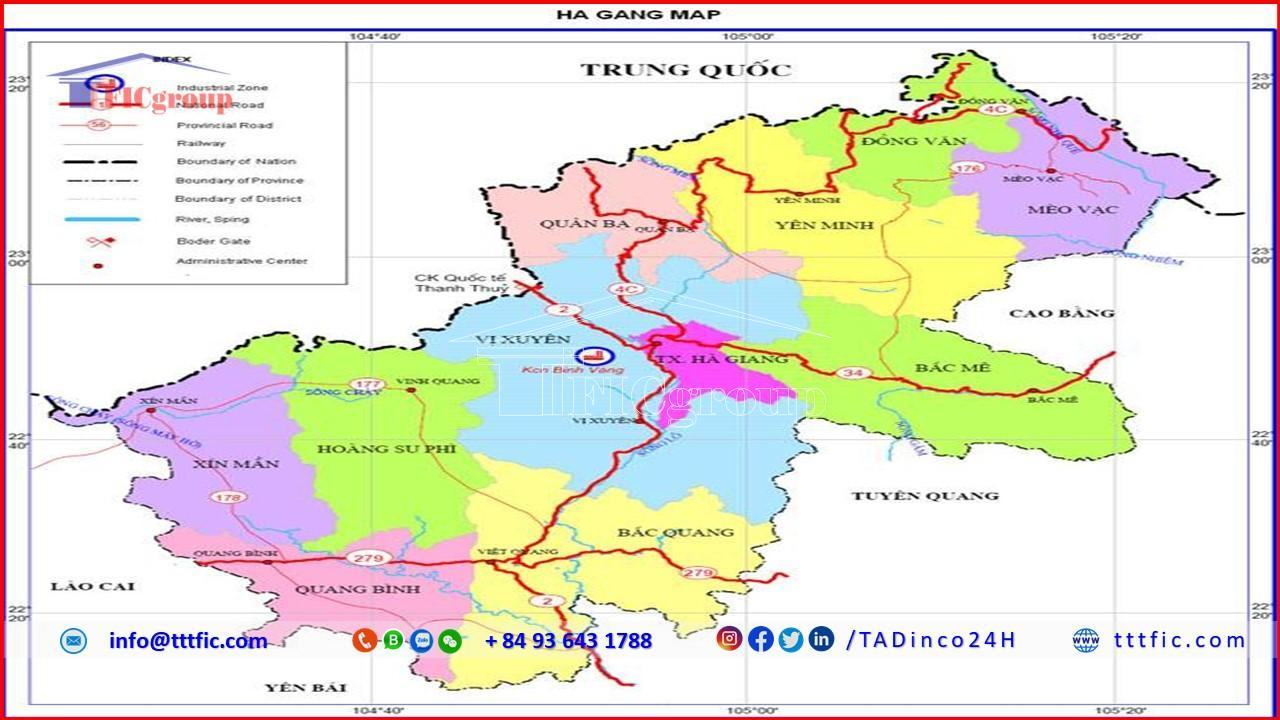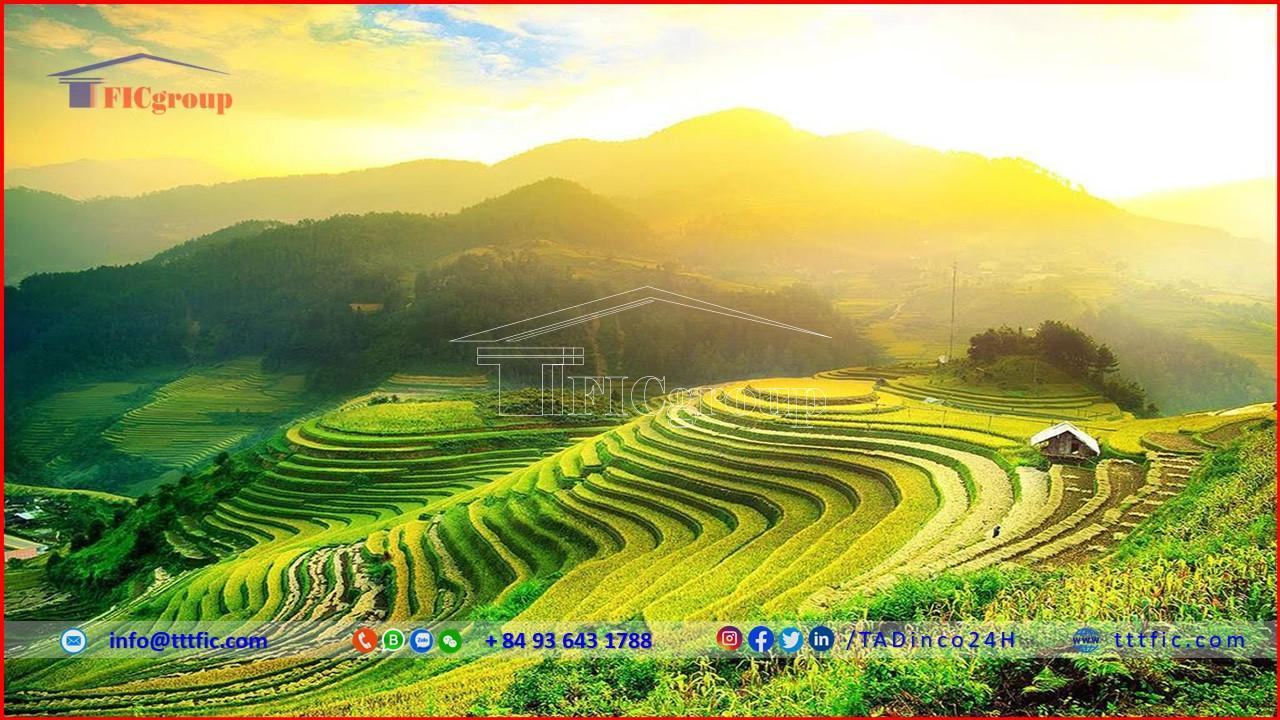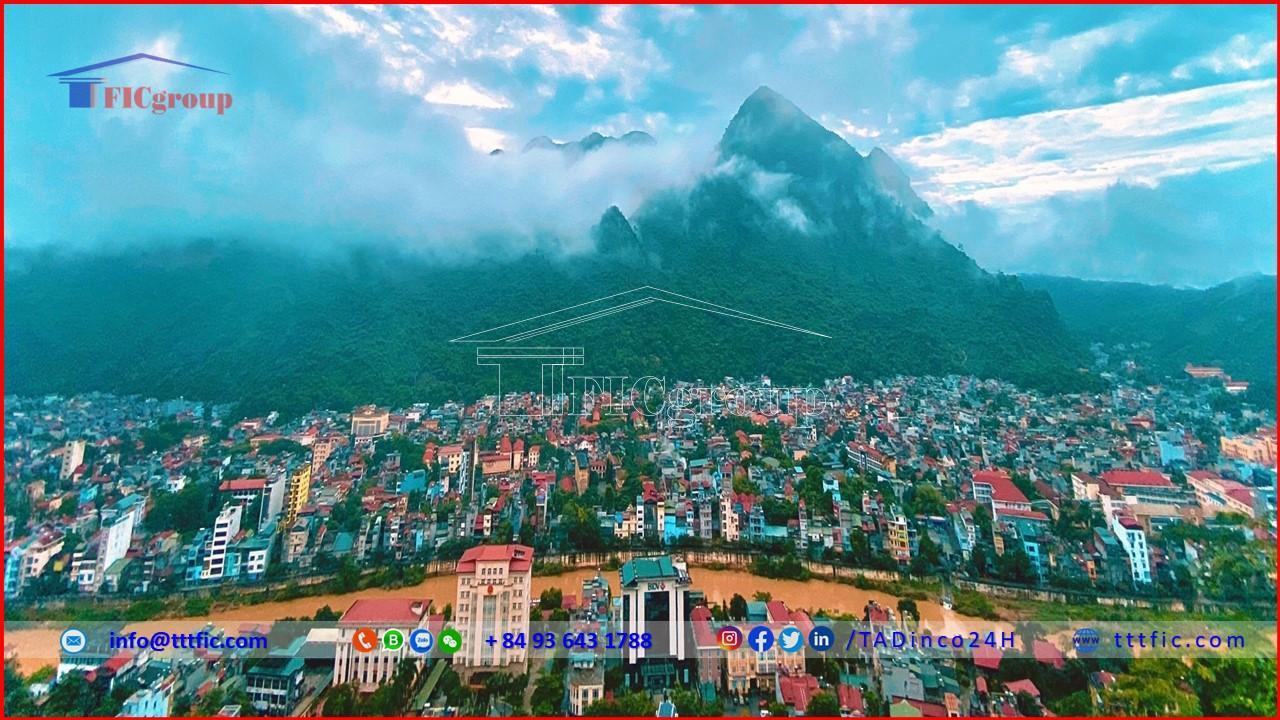Ha Giang Province
Located in the northeastern part of Vietnam, Ha Giang Province is a captivating destination known for its breathtaking landscapes and rich cultural heritage. Nestled amidst majestic mountains and lush green valleys, this enchanting province offers visitors an immersive experience in the untouched beauty of nature. From towering limestone karsts to vibrant terraced rice fields, Ha Giang is a haven for adventurers, nature enthusiasts, and those seeking an authentic cultural encounter. With its vibrant ethnic communities, traditional markets, and traditional festivals, Ha Giang showcases the diversity and vibrant traditions of the Vietnamese people. Embarking on a journey to Ha Giang, you will be captivated by its awe-inspiring beauty, warm hospitality, and a world waiting to be explored.

ha-giang-province-tttfic-group
I. Natural conditions:
1. Geographic location:
- Ha Giang is a mountainous province located in the northernmost part of Vietnam.
- The province shares borders with the People’s Republic of China to the north and west, Cao Bang to the east, Tuyên Quang to the south, and Lao Cai and Yen Bai to the west and southwest.
- The natural area of Hà Giang is 7,929.5 square kilometers. The province consists of 1 city, 10 districts, 5 wards, 13 townships, and 177 communes.
2. Topography:
- Ha Giang is situated in the high mountainous region of northern Vietnam, with diverse and rugged terrain.
- The average elevation of the province ranges from 800 meters to 1,200 meters above sea level.
- Ha Giang has numerous high mountain peaks, with a total of 49 peaks ranging from 500 meters to 2,500 meters.
- Ha Giang’s topography divides into three main regions: the Đong Van limestone plateau in the north, the Hoang Su Phi and Xin Man districts in the west, and the remaining districts and townships in the lowland mountainous region.
3. Hydrology:
- Ha Giang has many rivers and streams, mainly belonging to the Hồng River system.
- The Lo River, Chay River, and Gam River are major rivers in the province, providing important water resources for the area.
- Additionally, there are many other small rivers and streams throughout the province.
4. Climate:
- Ha Giang falls within the tropical monsoon climate zone and is a highland region, characterized by the characteristics of the Northeast Vietnam – Hoang Lien Son mountainous region.
- However, Ha Giang’s climate has its own distinctiveness, being cooler and colder than the provinces in the Northeast, but warmer than the provinces in the Northwest.
- The province has abundant rainfall, with an average annual precipitation ranging from 2,300 to 2,400 millimeters.
- The average annual humidity reaches 85%, with the peak season in June, July, and August.
- Ha Giang also experiences many cloudy days with little sunshine, with an average wind speed of about 1 – 1.5 meters per second, and many days with thunderstorms, drizzles, and fog.

ha-giang-province-tttfic-group
II. Natural resources:
1. Land resources:
- According to the Statistical Yearbook 2021, Ha Giang province has a total land area of 792,755 hectares.
- Of this, agricultural land covers 201,268.3 hectares, forestry land covers 472,808.8 hectares, specialized land covers 22,589.5 hectares, and residential land covers 7,795.8 hectares.
- Ha Giang has 9 main soil groups, with the majority being gray soil, which is suitable for cultivating industrial crops, medicinal plants, and fruit trees.
2. Forest resources:
- Ha Giang has a relatively large forest area, with over 345,860 hectares of natural forests.
- These forests are home to many rare and endangered animal species. Some examples are bears, serows, gibbons, pheasants, and eagles. Additionally, there are various valuable timber species like agarwood, agarwood pine, lat hoa, lat chun, đinh, nghien, tro chi, and thong đa.
- The forests in Ha Giang have multiple roles. They protect the ecological environment of the Northern Delta region. They also provide resources for industries, construction, and healthcare.
- The forests in Hà Giang province serve as ideal ecotourism destinations. They contain unexploited primary forests and fascinating landscapes. Basalt forests, caves, and landmarks like Co Tien Mountain and Cong Troi (Heaven’s Gate) are found there.
3. Mineral resources:
- Through surveys and explorations, Hà Giang has discovered 28 different types of minerals.
- Notably, there are large deposits of minerals with high mineral content, such as antimony in the Mau Due and Bo Moi mines, iron in the Tung Ba and Bac Me mines, and lead-zinc in Na Son, Ta Pan, Bang Lang, and Cao Ma Po.
- Other minerals found in the province include pyrite, tin, lead, copper, manganese, gold in mineral sand, gemstones, kaolin, mineral water, clay for brick production, non-coal minerals, and mud coal. Currently, some mines are being efficiently exploited.
4. Aquatic resources:
- Despite being a mountainous province, Ha Giang has notable aquatic resources.
- This region is home to rare and valuable aquatic species.
- In the Gam River basin, there are shrimps, crabs, and fish that can only be found in rocky areas of the river. Ca Dam xanh (green carp) and ca Anh vu (mandarin fish) are famous specialty fish that were once offered at the royal court.
- The Lo River also contains special fish and shrimps such as carp, bong fish, mang fish, and ba ba fish.
- Recently, local people have utilized water surfaces, ponds, lakes, and reservoirs to breed and raise short-growth and high-yield shrimp and fish species.
- Many farmers also combine rice cultivation with fish farming in wet rice fields.
- This has brought about significant economic benefits, with many farms developing under the VACR model (garden, pond, cage, and forest).

ha-giang-province-tttfic-group
III. Economic Potential:
1. Key economic sectors:
Ha Giang has the potential to develop in various economic sectors, including mining industry (antimony and cinnamon), construction materials production, agricultural processing, and forestry.
The province also has favorable conditions for transit tourism, with good climate, beautiful landscapes, and hot springs. The total provincial budget revenue in 2018 reached 2,033 billion VND.
Ha Giang has a sparsely populated province, with the majority being the Mong ethnic group and other ethnic groups such as Tho, La Chi, Tay, Dao, Man, Nung, Giay, and Lo Lo. The province’s economy has not yet achieved strong development due to its mountainous and forested terrain. Forestry mainly focuses on precious woods and other tree species such as lat hoa, lat da đong, lim, sen, trai, tau, and dinh.
Agricultural products include rice, maize, potatoes, and legumes, along with tea in the Tay Con Linh foothill area. Ha Giang also possesses mineral resources such as iron ore, lead mines, copper, mercury, and alluvial gold. The main commercial activities revolve around the exchange of forest products with other regions and China. Lowland areas like Vi Xuyen and Bac Quang have more developed economies. They benefit from water resources from the Lo River and agricultural development. These areas have thriving citrus cultivation and other agricultural activities. Ha Giang is known for its specialized products, including Shan Tuyet ancient tea. Shan Tuyet tea is exported to Taiwan, Japan, and several countries in Western Europe.
2. Tourism potential:
Giang has significant tourism potential due to its rich cultural heritage, prehistoric relics, and diverse ethnic communities. The province boasts unique environmental landscapes, including high rocky mountain ranges and vast forests.
The Dong Van Karst Plateau Geopark and Hoang Su Phi Terraced Fields are recognized UNESCO heritage sites. Ha Giang also offers tourist attractions such as Lake Noong, hot springs, Suoi Tien, Heaven’s Gate, Quang Ngan Waterfall, Nam Ma area, golden and silver chums (traditional houses), and the Vuong family historical site. Additionally, the transit tourism to Yunnan, China, is another strength of Ha Giang.
IV. Population:
According to the population census on April 1, 2019, the population of Ha Giang province was 854,679 people, with an urban population accounting for 15.8% of the total population. The major ethnic groups include H’Mong (32.9%), Tay (23.2%), Dao (14.9%), Viet (12.8%), and Nung (9.7%)…
As of April 1, 2019, the province had 7 different religions, with a total of 40,393 followers. Protestantism is the largest religion with 35,960 followers, followed by Catholicism with 4,110 followers, and Buddhism with 290 followers. There are also other religions such as Islam (26 people), Cao Dai (three people), Hoa Hao Buddhism (three people), and Minh Ly religion (one person).

ha-giang-province-tttfic-group
V. Festivals:
Over 20 ethnic groups reflect their traditional cultures through unique festivals, making Ha Giang renowned. Visitors to Ha Giang can experience the distinct cultural products such as embroidered scarves, fabric bags, and traditional dresses with vibrant patterns. They can also participate in charming highland markets.
- The Lo Lo Ethnic Group celebrates their new house for 2 days and 2 nights with the whole village. The priests sing, and then everyone enjoys eating, playing, performing flute and saxophone music, and engaging in male-female duet singing.
- The Spring Festival of the H’mong and Dao ethnic groups takes place after the Lunar New Year and lasts from 3 to 7 days. The festival celebrates achievements, prays for rain, and seeks fertility. Activities include crossbow shooting, duet singing, pa pao throwing, wine drinking, and feasting.
- The Mong Ethnic Group’s Butt Slapping Festival occurs on the 5th day of the Lunar New Year. Young people find their potential spouses by playfully slapping the buttocks of their preferred candidates and waiting for a response.
- The Fire Dance Festival of the Pa Then people is held in the evening on the last day of the year. The fire is lit for rituals, celebrating the harvest season, and seeking the blessings of deities for the new year. Many people jump through the fire and embers after being spiritually empowered by the shaman.
VI. Cuisine:
Ha Giang offers a variety of specialties and distinctive dishes, including Bac Quang oranges, thang co (a special soup), Hoang Su Phi red plums, Lung Phin tea, Bac Me bamboo rice, mang nua (bamboo shoot salad), Ha Giang black chicken, Gia Diu black sticky rice, au tau porridge, Đong Van pears, and black cat pumpkin seeds from Ha Giang…




